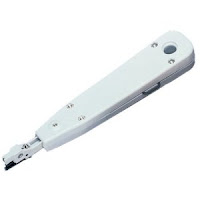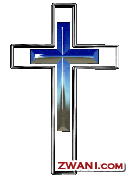 A punch down tool, also called a punchdown tool or a Krone tool (after wiring systems manufacturer ADC Krone), is a small screw-driver sized tool used for connecting wiring to a punch down block[1]. The tool consists of a handle with a spring mechanism inside and at the tip a small square piece of metal with a square hole in it. To use the punch down tool, a wire is inserted in between the two metal blades on a punch down block and the punch down tool is pressed down on top of the wire and the two blades on the punch down block. This requires a bit of pressure until with an audible snap the wire is stripped and contact made as it is pushed down between the two punch down block blades.
A punch down tool, also called a punchdown tool or a Krone tool (after wiring systems manufacturer ADC Krone), is a small screw-driver sized tool used for connecting wiring to a punch down block[1]. The tool consists of a handle with a spring mechanism inside and at the tip a small square piece of metal with a square hole in it. To use the punch down tool, a wire is inserted in between the two metal blades on a punch down block and the punch down tool is pressed down on top of the wire and the two blades on the punch down block. This requires a bit of pressure until with an audible snap the wire is stripped and contact made as it is pushed down between the two punch down block blades.
Wednesday, December 19, 2007
PUNCH DOWN TOOL
Posted by JeB at 5:44 PM 0 comments
PATCH PANEL



A patch panel is mounted hardware unit containing an assembly of port locations in a communications or other electronic electrical system.In a network(LAN) and to the outside for connection to the Internet or other wide area network(WAN).A patch panel uses a sort of jumper cable called a patch cord to create each interconnection.Cat 5e patch panel is available in 12 to 72 ports.All panels are 19 inch rack mount and support both 568A and 568B installations. Compatible with both 110 Block、LSA Block and block.
A patch panel or patch bay is a panel, typically rackmounted, that houses cable connections. One typically shorter patch cable will plug into the front side, while the back will hold the connection of a much longer and more permanent cable. The assembly of hardware is arranged so that a number of circuits, usually of the same or similar type, appear on jacks for monitoring, interconnecting, and testing circuits in a convenient, flexible manner.Patch panels offer the convenience of allowing technicians to quickly change the path of select signals, without the expense of dedicated switching equipment. This was first used by early telephone exchanges, where the telephone switchboard (a massive array of patch panels) and a large room full of telephone operators running it was ubiquitous.
Uses and connectors
They are not only used in telephony and data, but in other audio and video applications. Patch bays are used at installations where it is necessary to connect and reconnect various hardware devices, for example at technical control facilities, patch and test facilities, at telephone exchanges, broadcast studios, and recording studios.
Patch panels can have any number of different types of electrical connectors, often having a different type on the front than the back. If it has a compound connector on the back and individual ones on the front, it is also a breakout box. One example is a DB25 connector used for 8-channel balanced line audio, which is split into eight XLR or TRS connectors on the front.
Patch bays facilitate flexibility in the use, routing or restoration of a variety of circuit types, such as dc, VF, group, coaxial, equal-level, and digital data circuits. Patch panels accepting industry standard keystone modules are also available, allowing a variety of connectors to be used on a single panel.
In telephony and data, the 66 block and 110 block are punch blocks often used as patch panels. These have insulation-displacement connectors for quick wiring of wires which have no attached connectors. Old switchboards used tip-ring (TRS) connectors on the front, still the most common type used now for audio.
Posted by JeB at 5:26 PM 0 comments
Wednesday, November 21, 2007
What is the difference between CSMA/CD and CSMA/CA?
CSMA/CA (Carrier Sense Multiple Access/Collision Avoidance) is the channel access mechanism used by most wireless LANs in the ISM bands. A channel access mechanism is the part of the protocol which specifies how the node uses the medium : when to listen, when to transmit...
The basic principles of CSMA/CA are listen before talk and contention. This is an asynchronous message passing mechanism (connectionless), delivering a best effort service, but no bandwidth and latency guarantee (you are still following ?). It's main advantages are that it is suited for network protocols such as TCP/IP, adapts quite well with the variable condition of traffic and is quite robust against interferences.
CSMA/CA is fundamentally different from the channel access mechanism used by cellular phone systems.
CSMA/CA is derived from CSMA/CD (Collision Detection), which is the base of Ethernet. The main difference is the collision avoidance : on a wire, the transceiver has the ability to listen while transmitting and so to detect collisions (with a wire all transmissions have approximately the same strength). But, even if a radio node could listen on the channel while transmitting, the strength of its own transmissions would mask all other signals on the air. So, the protocol can't directly detect collisions like with Ethernet and only tries to avoid them.
Under CSMA/CD, when a station has data to send, it first listens to determine whether any other station on the network is occupying the medium. If the channel is busy, the station will wait until it becomes idle before transmitting data. Since it is possible for two stations to listen at the same time and discover an idle channel, it is also possible that two stations could then transmit at the same time. When this occurs a collision will take place, and then a jamming signal is sent throughout the network in order to notify all stations of the collision. The stations will then wait for a random period of time before re-transmitting their respective frames.
Posted by JeB at 7:49 PM 4 comments
-TEMA-
 log on to our Web site:
log on to our Web site:
www.myspace.com/temadavao
where you can listen TEMA's compositions
local bands and local music...
...no matter where "local" is to you.
All MUSIC you want for!
Posted by JeB at 7:43 PM 0 comments
My MUSIC
Music
Music,
Music Is Life,
Without It We Would Be In Strife,
Music Is My Whole World,
Without Music My Life Would Deserve To Be Hurled.
Music Is Love,
Music Is Like A Dove,
Music Is Passion,
Where Do You Think Everyone Gets Compassion.
Music Is What Keeps Us Alive,
It Helps Us Thrive,
Music Consumes You,
It Never Wants To Say Adeiu.
Music.
Posted by JeB at 7:14 PM 0 comments




